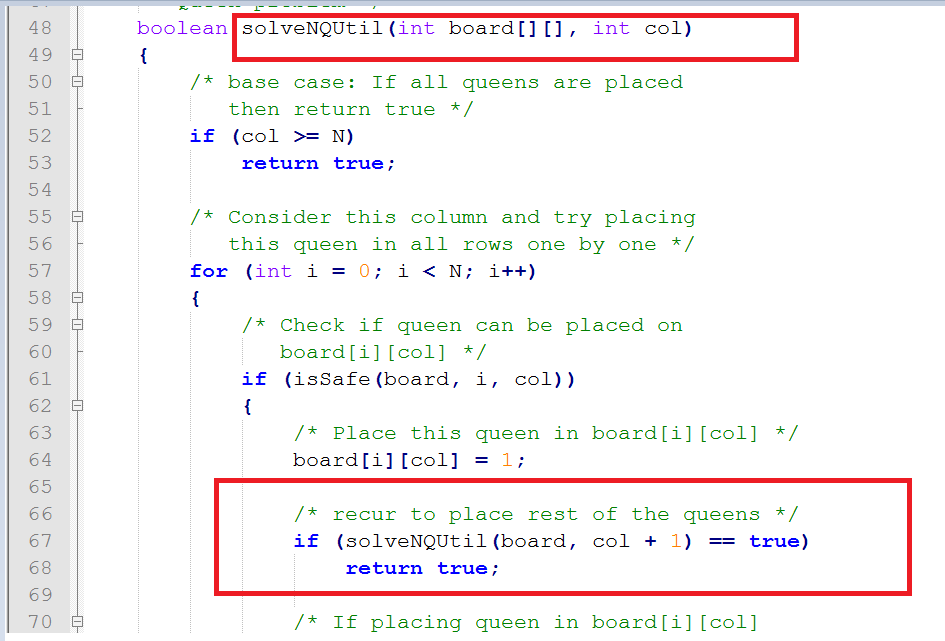Q1可以放在任何位置;
然后尝试Q2,因为Q1的限制,Q2必须排除第二列与Q1行数插值大于2的位置;
当Q1尝试过首列所有位置后,算法结束。
依次尝试Qm... 如果Qm上没有剩余可用位置,则返回Qm-1,同时使Qm-1 放弃刚才使用位置;
当到达结尾Qn时,成功放置,则存储所有位置,作为一种解法;
Qm是什么?一共有m个queen?
2. Geek上获得的java解法:
最关键的就是再这里递归方法调用的同时往后走到下一列, 第一个queen放在第一列:

/* Java program to solve N Queen Problem using backtracking */ public class NQueenProblem { final int N = 4; /* A utility function to print solution */ void printSolution(int board[][]) { for (int i = 0; i < N; i++) { for (int j = 0; j < N; j++) System.out.print(" " + board[i][j] + " "); System.out.println(); } } /* A utility function to check if a queen can be placed on board[row][col]. Note that this function is called when "col" queens are already placeed in columns from 0 to col -1. So we need to check only left side for attacking queens */ boolean isSafe(int board[][], int row, int col) //col is the current column... { int i, j; /* Check this row on left side , not allwed as long as there are data in the left same line */ for (i = 0; i < col; i++) if (board[row][i] == 1) return false; /* Check upper diagonal on left side */ for (i=row, j=col; i>=0 && j>=0; i--, j--)//这种二维同时循环我表示很费解,要想不一样的递减程度咋办? if (board[i][j] == 1) return false; /* Check lower diagonal on left side */ for (i=row, j=col; j>=0 && i<N; i++, j--) if (board[i][j] == 1) return false; return true; } /* A recursive utility function to solve N Queen problem */ boolean solveNQUtil(int board[][], int col) { /* base case: If all queens are placed then return true */ if (col >= N) return true; /* Consider this column and try placing this queen in all rows one by one */ for (int i = 0; i < N; i++) { /* Check if queen can be placed on board[i][col] */ if (isSafe(board, i, col)) { /* Place this queen in board[i][col] */ board[i][col] = 1; /* recur to place rest of the queens */ if (solveNQUtil(board, col + 1) == true) return true; /* If placing queen in board[i][col] doesn't lead to a solution then remove queen from board[i][col] */ board[i][col] = 0; // BACKTRACK } } /* If queen can not be place in any row in this colum col, then return false */ return false; } /* This function solves the N Queen problem using Backtracking. It mainly uses solveNQUtil() to solve the problem. It returns false if queens cannot be placed, otherwise return true and prints placement of queens in the form of 1s. Please note that there may be more than one solutions, this function prints one of the feasible solutions.*/ boolean solveNQ() { int board[][] = {{0, 0, 0, 0}, {0, 0, 0, 0}, {0, 0, 0, 0}, {0, 0, 0, 0} }; if (solveNQUtil(board, 0) == false) { System.out.print("Solution does not exist"); return false; } printSolution(board); return true; } // driver program to test above function public static void main(String args[]) { NQueenProblem Queen = new NQueenProblem(); Queen.solveNQ(); } } // This code is contributed by Abhishek Shankhadhar
/* Java program to solve N Queen Problem using backtracking */public class NQueenProblem{ final int N = 4; /* A utility function to print solution */ void printSolution(int board[][]) { for (int i = 0; i < N; i++) { for (int j = 0; j < N; j++) System.out.print(" " + board[i][j] + " "); System.out.println(); } } /* A utility function to check if a queen can be placed on board[row][col]. Note that this function is called when "col" queens are already placeed in columns from 0 to col -1. So we need to check only left side for attacking queens */ boolean isSafe(int board[][], int row, int col) { int i, j; /* Check this row on left side */ for (i = 0; i < col; i++) if (board[row][i] == 1) return false; /* Check upper diagonal on left side */ for (i=row, j=col; i>=0 && j>=0; i--, j--) if (board[i][j] == 1) return false; /* Check lower diagonal on left side */ for (i=row, j=col; j>=0 && i<N; i++, j--) if (board[i][j] == 1) return false; return true; } /* A recursive utility function to solve N Queen problem */ boolean solveNQUtil(int board[][], int col) { /* base case: If all queens are placed then return true */ if (col >= N) return true; /* Consider this column and try placing this queen in all rows one by one */ for (int i = 0; i < N; i++) { /* Check if queen can be placed on board[i][col] */ if (isSafe(board, i, col)) { /* Place this queen in board[i][col] */ board[i][col] = 1; /* recur to place rest of the queens */ if (solveNQUtil(board, col + 1) == true) return true; /* If placing queen in board[i][col] doesn't lead to a solution then remove queen from board[i][col] */ board[i][col] = 0; // BACKTRACK } } /* If queen can not be place in any row in this colum col, then return false */ return false; } /* This function solves the N Queen problem using Backtracking. It mainly uses solveNQUtil() to solve the problem. It returns false if queens cannot be placed, otherwise return true and prints placement of queens in the form of 1s. Please note that there may be more than one solutions, this function prints one of the feasible solutions.*/ boolean solveNQ() { int board[][] = {{0, 0, 0, 0}, {0, 0, 0, 0}, {0, 0, 0, 0}, {0, 0, 0, 0} }; if (solveNQUtil(board, 0) == false) { System.out.print("Solution does not exist"); return false; } printSolution(board); return true; } // driver program to test above function public static void main(String args[]) { NQueenProblem Queen = new NQueenProblem(); Queen.solveNQ(); }}// This code is contributed by Abhishek Shankhadhar
|


